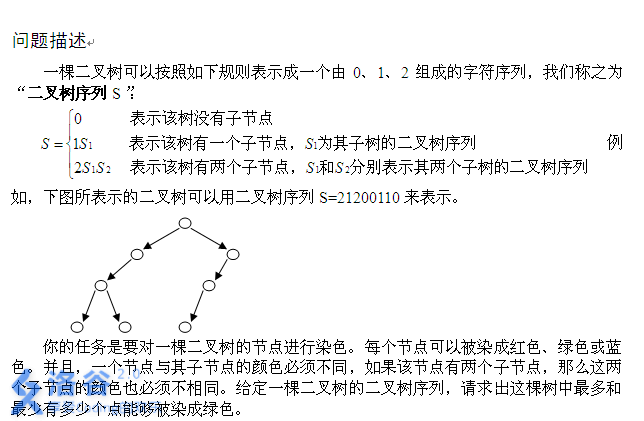Describe
题目链接

Solution
$0-$绿色,$1-$红色,$2-$蓝色。 设$f[i][j]$表示$i$节点染成$j$这种颜色的最大值。 如果$i$节点的没有儿子,那么很明显$f[i][0]=1$。 如果$i$节点有一个儿子,那么$f[i][0]=max(f[to][1],f[to][2])+1,f[i][1]=max(f[to][0],f[to][2])$(颜色染成蓝色与红色类似) 如果$i$节点有两个儿子,那么$f[i][0]=max(f[lson][1]+f[rson][2],f[lson][2]+f[rson][1])+1$(颜色染成红色、蓝色只需不用$-1$即可) 最大值如此,最小值类似。
Code
1
2
3
4
5
6
7
8
9
10
11
12
13
14
15
16
17
18
19
20
21
22
23
24
25
26
27
28
29
30
31
32
33
| #include<bits/stdc++.h>
using namespace std;
char str[500010];
int f[500010][3],g[500010][3],tot;
inline void DFS(int x){
if(str[x]=='0'){
f[x][0]=g[x][0]=1;
return ;
}else if(str[x]=='1'){
int son=x+1;
DFS(++tot);
f[x][0]=max(f[son][1],f[son][2])+1;
f[x][1]=max(f[son][0],f[son][2]);
f[x][2]=max(f[son][0],f[son][1]);
g[x][0]=min(g[son][1],g[son][2])+1;
g[x][1]=min(g[son][0],g[son][2]);
g[x][2]=min(g[son][0],g[son][1]);
}else if(str[x]=='2'){
int l=x+1;DFS(++tot);
int r=tot+1;DFS(++tot);
f[x][0]=max(f[l][1]+f[r][2],f[l][2]+f[r][1])+1;
f[x][1]=max(f[l][0]+f[r][2],f[l][2]+f[r][0]);
f[x][2]=max(f[l][0]+f[r][1],f[l][1]+f[r][0]);
g[x][0]=min(g[l][1]+g[r][2],g[l][2]+g[r][1])+1;
g[x][1]=min(g[l][0]+g[r][2],g[l][2]+g[r][0]);
g[x][2]=min(g[l][0]+g[r][1],g[l][1]+g[r][0]);
}
}
int main(){
cin>>str+1;
DFS(++tot);
cout<<max(f[1][0],max(f[1][1],f[1][2]))<<" "<<min(g[1][0],min(g[1][1],g[1][2]))<<endl;
}
|
